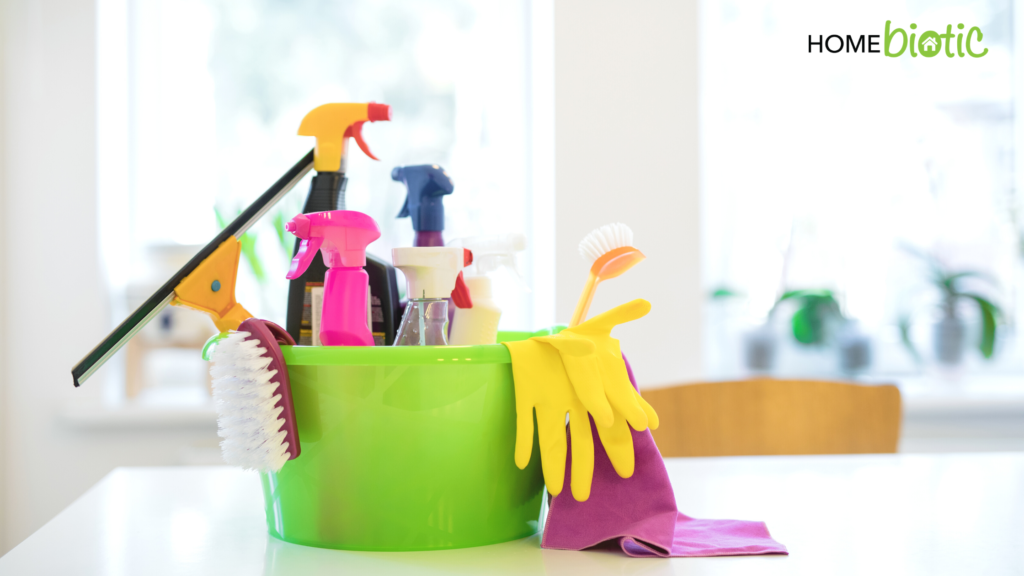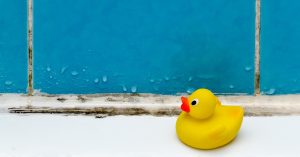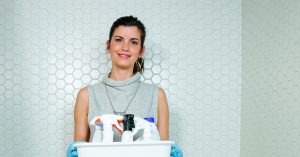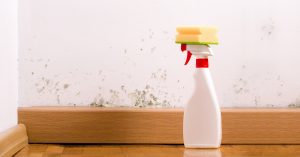
Although minor mold spots are easy enough to wipe away while cleaning, the mold often returns quickly. While you might think to reach for the disinfectant spray or prepare a bucket of bleach to douse the area to kill it once and for all, these are not the best solutions for fixing a mold issue. These disinfectants are named for their ability to dis-infect, or kill, microbes and while that may sound good, in many cases this can actually make a mold problem worse!

If you look underneath the sink of an average home, you’re most likely going to find a variety of disinfectants, including bleach. Bleach is often a go-to remedy for stubborn stains and is used for making areas of the kitchen and bathroom sanitized and clean, but have you ever wondered why?
The most common kind of bleach is chlorine bleach, a water-based solution containing sodium hypochlorite as the active ingredient. Bleach removes stains from fabrics and non-porous surfaces by oxidizing and breaking down networks of double bonds between the carbon atoms making up the discoloration, removing the stain’s ability to absorb light. So the bleach doesn’t really neutralize and break down the matter creating the stain completely, just the bonds that make it visible to the human eye!
 DOWNSIDES OF USING BLEACH
DOWNSIDES OF USING BLEACHWhen you apply bleach to mold or mildew on tile grout, for example, it’s killing what’s on the surface and lightening the stain that the mold growth has caused, which makes it look as though it’s gone. But, that’s not the whole picture.
Bleach only works well on non-porous surfaces, and isn’t effective on porous surfaces such as wood, drywall or tile grout. While it may be effective at killing mold on the surface, the chlorine is unable to penetrate into the surface, so is either left on the surface or evaporates into the air of your home. Meanwhile, some of the water does seep into the surface and provides moisture to help the surviving mold grow back. And it does, more quickly each time it seems! If that wasn’t bad enough, you’ve now added harmful volatile organic compounds (VOCs) in your home as well.
Bleach only works well on non-porous surfaces, and isn't effective on porous surfaces such as wood, drywall or tile grout. While it may be effective at killing mold on the surface, the chlorine is unable to penetrate into the surface,… Click To TweetAnother reason to not use bleach to clean mold is even if the actively growing mold is killed, many of the health effects of mold are actually due to their byproducts, called mycotoxins, which bleach doesn’t affect. Bleach is also highly irritating to use, and should only be used with personal protective gear such as eye protection, a mask, and gloves, as well as good ventilation. For these reasons, we definitely recommend against using bleach to clean mold.
 IS HYDROGEN PEROXIDE BETTER?
IS HYDROGEN PEROXIDE BETTER?Hydrogen peroxide is often referred to as an oxygen bleach, because it acts as an oxidizer, chemically attacking the cell wall of bacteria, often rupturing it entirely. Regular 3% hydrogen peroxide is effective at killing surface mold, and only needs to be sprayed on and left for 10 minutes or until it stops fizzing. Repeat as necessary until the visible mold is gone, taking care to not over-wet the surface.
The Homebiotic Surface Cleaner is also an effective way to clean mold as it contains citric acid. Unlike conventional chemical cleaning products, that strip beneficial microbes from home surfaces, Homebiotic allows you to clean surfaces naturally without harsh chemicals that damage your home biome. Following up your cleaning with the Homebiotic Probiotic Spray will help you maintain a natural, safe balance of microbes on surfaces, which will protect your home and family against exposure to toxins that could negatively impact your health.
Regardless of what product is used to clean a surface, if the surface is left bare it will quickly be repopulated. If nothing is done, either sub-surface mold will grow back, or perhaps a harmful bacteria lurking in your kitchen or bathroom will move in.
These friendly bacteria naturally balance out these unwanted guests. When cleaning your home, and especially when cleaning mold growth, applying the Homebiotic Probiotic Spray immediately afterwards will help keep these surfaces stay clean at a microscopic level. Homebiotic Probiotic Spray is colorless and scent-free, so you won’t even notice it’s there. It just forms a probiotic barrier for your home… naturally.

Gillian is a former nurse and joined the Homebiotic team as a researcher & science writer. She loves traveling the world and currently lives in Colombia.
Subscribe to our newsletter
© 2024 Homebiotic Inc. All rights reserved. | Privacy Policy | Terms of Use These statements have not been evaluated by the FDA. Homebiotic is not intended to diagnose, treat, cure, or prevent any disease.